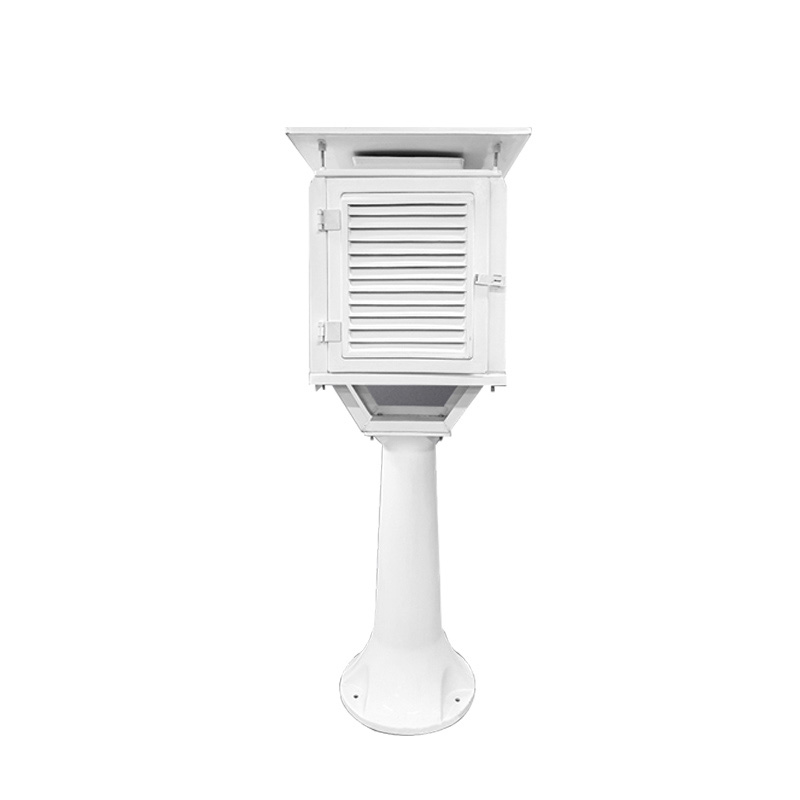Tianyi Sensor IOT Technology Co., Ltd
Sales Manager:Ms. Emily Wang
Cel,Whatsapp,Wechat:+86 15898932201
Email:info@fengtutec.com
Add:No. 155 Optoelectronic Industry Accelerator, Gaoxin District, Weifang, Shandong, China

Sales Manager:Ms. Emily Wang
Cel,Whatsapp,Wechat:+86 15898932201
Email:info@fengtutec.com
Add:No. 155 Optoelectronic Industry Accelerator, Gaoxin District, Weifang, Shandong, China

Model:FT-BLG1
Brand:tianyi
1.Weather Instrument Shelter Product Overview
Weather Instrument Shelter is a professional weather shelter designed to protect certain weather instruments from exposure to direct sunlight.Weather Instrument Shelter consists of three parts: louvered box, connecting bracket and base, all of which are made of high-quality fiberglass.
Both the design principle and the comparison test show that it not only overcomes the problems of perishing, easy to crack and short life of the log louver box, but also significantly improves the comprehensive performance of ventilation, heat insulation, radiation protection and weather protection.
2.Product features of Weather Instrument Shelter
1.The material is made of fiberglass with low thermal conductivity, small heat capacity, corrosion resistance, crack resistance and strong anti-radiation force.Weather Instrument Shelter does not rot in rainy, acid rain, and humid environments, does not crack under drought and scorching sun, and has a long life.
2.The structure adopts an inverted "V" overall frame layered tightening structure, which is strong and will not loosen.It can not only ensure the normal exchange of gas inside and outside the box, but also effectively prevent rain and snow from blowing into the box.The upper cover plate has been changed to an inverted "funnel-type" ventilation cover.In the clear and windless situation and the sharp changes in the external environment, the gas inside and outside the box can be exchanged quickly, and the internal and external environment will quickly become consistent, making the observation data more accurate and representative.
3.Weather Instrument Shelter has beautiful and elegant shape, snow-white and smooth surface, no need for paint care, and its service life is more than fifteen years.The performance is relatively high and affordable.
3.Use of Weather Instrument Shelter Products
Used for conventional air temperature and humidity observation.
Because of the good insulation performance of Weather Instrument Shelter, it has electric suspension and excellent ventilation, rainproof, radiationproof and insect-proof properties, it can be used as a station for automatic hydrological and meteorological observation stations.
4.Main technical parameters of Weather Instrument Shelter
Louver box:
Box content: 520 (Length)×480 (Width)×610 (Height)(mm)
Dimensions: 720 (Length) × 780 (Width) × 880 (Height) (mm) Weight: 40kg
Connecting bracket: Height: 220 (mm) Weight: 7kg
Base: Height: 1050 (mm) Weight: 10kg.Installation: 3-Φ15 circumferential diameter Φ480 on the disk base plate, 120° aliquots
Overall height: 2150mm
(1) Specification parameters of the louver box: External dimensions: width 720× depth 780× height 880 (mm).The above-mentioned "door"-shaped blades, ventilation upper cover, base, top cover and other parts are made of high-quality fiberglass material, with a honeycomb structure inside, and the installation size is: 4-M1O.
(2) Top cover size: length 780×width 720×thickness 22 (mm).The section line is approximately cycloid, and the distance between the ventilation opening and the top cover is 10mm.On the inner base and ventilation cover of the box, the brackets are installed interlaced with wooden partitions, which are used for the installation and fixation of the observation instruments in the box.The base column is made of fiberglass material, with beautiful shape and lightweight.The coupling frame is composed of angle steel and has a surface plating treatment to connect the box and column.
The FT - WQX9 Outdoor Weather Sensors are common devices in the field of meteorological monitoring. Integrating multiple sensors, they can accurately measure data such as wind speed, wind direction, temperature, humidity, air pressure, PM2.5, PM10, rainfall, and solar radiation, providing real - tim...
The traditional triangle odor bag method mainly relies on the subjective judgment of professional odor assessors, which is not only cumbersome and costly to operate, but also difficult to achieve real-time monitoring and traceability. The emergence of the Odor Online Monitor has overcome these short...
The measurement of wind speed and direction is of great importance in many fields, such as weather forecasting, high - speed railways, wind power generation, industrial and agricultural production, and scientific research.In the traditional meteorological field, the measurement of wind speed and dir...
Agricultural meteorological disasters pose enormous threats to agricultural production. During droughts, prolonged water shortage causes soil to dry out, stunting or even killing crops. In severe cases, large-scale crop failures or even total harvest losses occur, with scenes of cracked land and no...